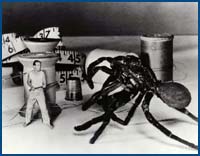The Biology of B-Movie Monsters
 The Biology of B-Movie Monsters
The Biology of B-Movie Monsters
Among the most interesting posts I've ever read.
Michael C. LaBarbera, professor in Organismal Biology & Anatomy & Geophysical Sciences at the College of the University of Chicago, has written an unbelievably interesting piece about the science behind horror movies like King Kong, The Incredible Shrinking Women, Them, and Fantastic Voyage. An incredibly interesting read.
In The Incredible Shrinking Man (1957), the hero is exposed to radioactive toxic waste and finds himself growing smaller and smaller. He is lost to family and friends while fending off the household cat and must make his own way in a world grown monstrously large. He forages food from crumbs and drinks from puddles of condensation. In one famous scene, he defends himself against a house spider by using an abandoned sewing needle, which he has to struggle to lift.Stop the projector! Time for a little analysis...
...As for the contest with the spider, the battle is indeed biased, but not the way the movie would have you believe. Certainly the spider has a wicked set of poison fangs and some advantage because it wears its skeleton on the outside, where it can function as armor. But our hero, because of his increased metabolic rate, will be bouncing around like a mouse on amphetamines. He wouldn't struggle to lift the sewing needle--he'd wield it like a rapier because his relative strength has increased about 70 fold. The forces that a muscle can produce are proportional to its cross-sectional area (length squared), while body mass is proportional to volume (length cubed). The ratio of an animal's ability to generate force to its body mass scales approximately as 1/length; smaller animals are proportionally stronger. This geometric truth explains why an ant can famously life 50 times its body weight, while we can barely get the groceries up the stairs; were we the size of ants, we could lift 50 times our body weight, too. As for the Shrinking Man, pity the poor spider.